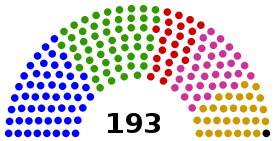Elections

The General Assembly is entrusted in the United Nations Charter with electing members to various organs within the United Nations system. The procedure for these elections can be found in Section 15 of the Rules of Procedure for the General Assembly. The most important elections for the General Assembly include those for the upcoming President of the General Assembly, the Security Council, the Economic and Social Council, the Human Rights Council and the International Court of Justice. Most elections are held annually, with the exception of the election of judges to the ICJ, which happens triennially.
The Assembly annually elects five non-permanent members of the Security Council for two year terms, 18 members of the Economic and Social Council for three-year terms and 14-18 members of the Human Rights Council for three year terms. It also elects the leadership of the next General Assembly session, i.e. the next President of the General Assembly, the 21 Vice-Presidents and the bureaux of the six main committees.
Elections to the International Court of Justice take place every three years in order to ensure continuity within the court. In these elections, five judges are elected for nine-year terms. These elections are held jointly with the Security Council, with candidates needing to receive an absolute majority of the votes in both bodies.
The Assembly also, in conjunction with the Security Council, selects the next Secretary-General of the United Nations. The main part of these elections are held in the Security Council, with the General Assembly simply appointing the candidate that receives the Council's nomination.
Regional groupsedit
The United Nations Regional Groups were created in order to facilitate the equitable geographical distribution of seats among the Member States in different United Nations bodies. Resolution 33/138 of the General Assembly states that “the composition of the various organs of the United Nations should be so constituted as to ensure their representative character.” Thus, member States of the United Nations are informally divided into five regions, with most bodies in the United Nations system having a specific number of seats allocated for each regional group. Additionally, the leadership of most bodies also rotates between the regional groups, such as the presidency of the General Assembly and the chairmanship of the six main committees.
The regional groups work according to the consensus principle. Candidates who are endorsed by them are, as a rule, elected by the General Assembly in any subsequent elections.
Comments
Post a Comment